The Genetics of Coloration in Texas Longhorns: Part 3: The Wild-type Color Variants
© David M. Hillis, Double Helix Ranch
Section of Integrative Biology, University of Texas, Austin, TX 78712

Texas Longhorns at the
Double Helix Ranch
This article is the third in a five-part series on the genetics of coloration in Texas Longhorn cattle. This article was published in Texas Longhorn Trails, Volume 16, number 6 (2004). If you have comments or questions about this article, please e-mail me.
This article is intended for a general audience of Texas Longhorn breeders, rather than a technical audience. However, some scientific jargon is unavoidable, so if any of the terms are unfamiliar, please see the Glossary.
Everyone has his or her own preferences about color of
Texas Longhorns. Black seems to have been a favorite over the past few
years, perhaps because it is less common in Texas Longhorns compared to
the various shades of reds and browns. Other people love roans of any
shade, and some people are enthusiastic about grullas. I enjoy a diversity
of color, but I find the various modifications of wild-type coloration
to be the most beautiful and interesting of Texas Longhorn colors. For
one thing, these are the colors that change the most through time; wild-type
colored calves are usually born some shade of red, and then darken with
age, and may appear almost black as adults (Figure 1). However, the degree
of expression of black pigment (eumelanin) varies considerably, and is
influenced by additional genes. These combinations of genes (together
with the wild-type allele at the Extension locus) produce some
of the most striking colors in Texas Longhorns, including brindle, Parker
brown, walnut, and wine-colored.
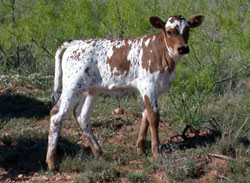 |
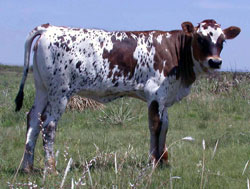 |
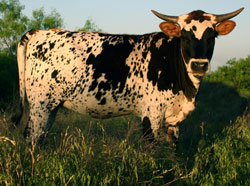 |
Many introductory books on cattle greatly simplify the
discussion of the genetics of cattle coloration, and may only present
information on black and red coloration. This is because the explanation
of the black and red alleles is relatively simple, and because many breeds
of cattle are fixed for one or the other of these two colors. There are,
in fact, just two pigments that affect hair color of cattle, and these
two pigments are black (eumelanin) and red (phaeomelanin). Black cattle
have both pigments, but they produce an excess of eumelanin, and this
essentially masks the red phaeomelanin. Red cattle produce little or no
eumelanin, and so their hair looks red. White cattle produce neither pigment
in their hair. It is doubtful if the red, black, or white colors were
found among the ancestral aurochs (the ancestors of modern European cattle),
at least in high frequency. These color patterns were selected by humans
early during the domestication of cattle, as a way to ensure breed purity
and because humans liked the diversity. In contrast, the aurochs are thought
to have had an allele that allowed differential and variable production
of both eumelanin and phaeomelanin, which produced a brown coloration
with areas of black (essential like the Parker brown coloration of Texas
Longhorns; Figure 2). The males were probably more darkly pigmented than
the females, and adults more darkly pigmented than juveniles. This occurred
because the relative expression of the two pigments changes in response
to the expression of other genes that are activated with maturation and
sexual differentiation. Texas Longhorns have retained all three of these
basic colors (black, red, and wild-type). The black allele is dominant
over the other two, and the wild-type coloration is dominant over red,
so individuals with wild-type coloration are either homozygous for the
wild-type allele (in other words, they have inherited the allele from
both parents), or else they are heterozygous for the wild-type and red
alleles (they inherited the wild-type allele from only one parent).
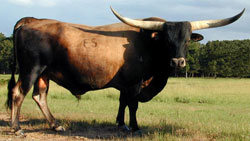
Figure 2. Primero Class, a Parker brown Texas
Longhorn bull co-owned by Malcolm and Connie
Goodman and Wes O’Neil
(photo courtesy of Malcolm Goodman).
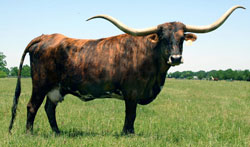
Figure 3. Day’s Feisty Fannie, a brindled
Texas Longhorn cow
(with record tip-to-tip horn measurement).

Figure 4. A Texas Longhorn cow (CO Barbwire)
with a complex brindled pattern that also
involves the Roan and Spotted genes.
Although all Texas Longhorns with wild-type coloration
can express both pigments, the relative degree of black and red pigmentation
is highly variable and is affected by several other genes. For instance,
there are two alleles at the Brindle locus (a dominant allele
that is abbreviated Br, and a recessive allele that is abbreviated
br). The Brindle gene has no obvious effects in true
red or black Texas Longhorns, but if at least one copy of the Br
allele is present in a wild-type colored individual, then that cow or
bull will be brindled (Figure 3). The degree of brindling may vary in
response to other factors, including sex differences, as males often show
more extensive (and typically darker) brindling patterns than do females.
In addition, complex brindle patterns can develop in response to interactions
with the various genes that produce areas of white, roan, or reduced pigmentation
(Figure 4).
Breeders are sometimes disappointed when a very colorful brindled bull
doesn’t produce similarly-colored offspring, but this is not unexpected.
For instance, if the bull is heterozygous for both wild-type coloration
and brindling, then he is expected to pass on both of these traits together
only about one-fourth of the time (half of the time he will pass only
one of the two traits to his calves, and the other fourth of the time
he will pass neither trait to his offspring). Even if he passes both wild-type
coloration and brindling to his offspring, they may show a lesser degree
of expression of the trait because of the influence of sex differences
or the effects of other genes (including the various genes that produce
areas of white). In addition, brindling typically develops with age, so
the calves will not be brindled at birth, even if they are expected to
develop this coloration as they age.
On the other hand, if a breeder wishes to breed all brindled cattle, then
a bull that is homozygous for both wild-type coloration and the dominant
brindle allele will always pass on both traits to his offspring. If this
bull is mated to either red or wild-type cows, then all of the offspring
are expected to show some degree of brindling. The degree of brindling
will be variable because of the effects of other genes, but some black
striping within areas of red or brown coloration should be present. The
only offspring that may not show any brindling are calves produced by
mating this bull with a black cow, because if the cow passes the black
allele on to the offspring then the calves will be black rather than brindled
(recall that the black Extension allele is dominant over the
wild-type Extension allele).
There are two color variants produced in cattle with wild-type coloration
that deserve special mention: walnut and wine coloration. Bulls with the
walnut coloration are often described as “black,” although
they are not truly black. They are usually born some shade of dark red
or brown, and then become nearly black as they mature. However, unlike
true black animals, they have a light-colored muzzle ring, and usually
a dark reddish-brown streak across the top of the head and backline (see
Figure 5). In addition, the “black” coloration on the rest
of the body is usually a deep, saturated walnut, with dark reddish brown
highlights. Females with this coloration typically show a much greater
degree of reddish pigment than do the males (Figure 6). Most Butler cattle
that are described as “black” actually have this coloration
(Ace’s Mojo is a well-known example). Many people consider the walnut
coloration to be one of most beautiful and striking colors that is present
in Texas Longhorns, and the deepening saturation of color that comes with
increasing age of the animals adds another dimension of interest.
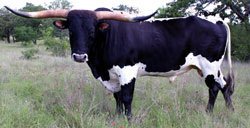
Figure 5. Crown’s Classic Shadow, a bull
with the wild-type “walnut” coloration.
Note the dark red hair on the poll,
and the prominent muzzle ring. This color
is often described as “black,” although
the animals are not true black.
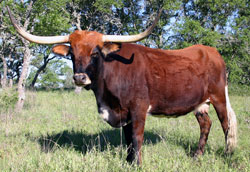
Figure 6. Females with the walnut coloration
usually show less expression of black pigment
than do males, and may appear deep red
with only small areas of black. However, they may
appear almost completely black as well. As with
other wild-type color variants, the muzzle ring on this
cow (Shadowette) is clearly visible.
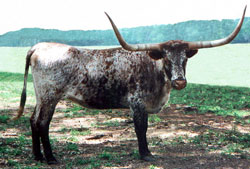
Figure 7. The wine roan coloration, another of the
wild-type color variants (photo of Delta Rockette
courtesy of Malcolm Goodman).
The wine or burgundy coloration is another variant of wild-type coloration
that is considered highly desirable by many breeders (Figure 7). This
coloration is also produced by a combination of eumelanin and phaeomelanin,
but the two pigments are present in lower concentration, to produce a
burgundy coloration. This pattern is a result of wild-type coloration
in combination with the Roan gene (I’ll discuss this gene
in more detail in Part 5 of this series).
As the photographs that accompany this article illustrate, any of the
colors of Texas Longhorns can appear with different patterns of white
(hairs that lack any pigment). Next month, I’ll discuss some of
these white patterns, including the spotted, lineback, and color-sided
patterns.
Want more detail? Please see the following papers:
Additional Reading and References
Joerg, H. et al. 1996. Red coat color in Holstein cattle is associated with a deletion in the MSHR gene. Mammalian Genome 7: 317-318.
Klungland, H. et al. 1995. The role of melanocyte-stimulating hormone (MSH) receptor in bovine coat color determination. Mammalian Genome 6: 636-639.
Lauvergne, J. J. 1966. Génétique de la couleur de pelage dex boivins domestiques. Bibliographia Genetica 20:1-168.
Olson, T. A. 1980. Choice of a wild-type standard in color genetics of domestic cattle. Journal of Heredity 71:442-444.
Olson, T. A. 1981. The genetic basis for piebald patterns in cattle. Journal of Heredity 72:113-116.
Olson, T. A. 1999. Genetics of Colour Variation. In The Genetics of Cattle (R. Fries and A. Ruvinsky, eds.). Pp. 33-53. CABI Publishing, Wallingford, United Kingdom.
Robbins, L. S. et al. 1993. Pigmentation phenotypes of variant extension locus alleles result from point mutations that alter MSH receptor function. Cell 72:827-834.